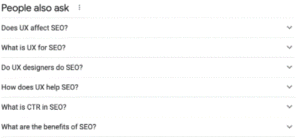5 UX Best Practices that Benefit SEO Rankings
User experience is a crucial component of your site’s design and marketing strategy that is often overlooked. UX impacts every aspect of your marketing campaign: from acquisition to conversion, particularly as it pertains to SEO.
In SEO it’s important to pay close attention to metrics such as bounce rate, average session duration, pages per session, and click-through rate to track how users engage with your site. Google considers these user engagement metrics to determine the quality of your site, which directly impacts your site’s organic search rankings.
Optimizing your site for UX not only keeps visitors on your site longer, it can also vastly improve your organic search visibility. Let’s take a look at 5 UX Best Practices you can implement to boost your organic search rankings:
 1. Keep Your Site Navigation Simple
1. Keep Your Site Navigation Simple
Your site’s navigation is crucial to UX, particularly for sites that sell products or services. It’s important that your products, services, resources and anything valuable to the user is easy to find. Therefore, your site’s navigation should be as intuitive as possible.
In order to achieve this we recommend the following practices:
- Group Similiar Pages Together:
The first thing to consider when determining your navigation is your site’s architecture. If your site contains a lot of pages, we recommend grouping similar pages together so you don’t overwhelm the user with too many options. Make sure that each page listed on your navigation provides its own value. It’s also important to be mindful of the title you choose for each page: we recommend using titles that are both succinct and descriptive. - Make your Navigation Responsive:
Just like the rest of your site, you want to make sure that your site navigation is responsive for mobile users. If your navigation is too large to fit on a home screen or too small to click on, users are likely to spend less time on your site. - Less Clicks:
The fewer clicks it takes to get to the page users are looking for, the better. Be mindful of your user’s navigation path and consider how many clicks it takes to get to your most popular landing pages. We recommend placing links to your most popular pages in the navigation or immediately on the home page.
 2. Optimize for Search Intent
2. Optimize for Search Intent
Considering the user’s search intent will not only keep users on your site, it can also be compensated by Google. Content that effectively answers commonly asked questions often appears in the People Also Ask section of Google. Additionally, pages that contain title tags and meta descriptions that are optimized with search intent in mind are more likely to have a higher click-through rate.
The following practices can help you be mindful of search intent:
- Use Keywords that Target Search Intent: An effective keyword strategy is one that targets both broad and specific search terms. One way to target both in a single key term, is by pairing broad, high-volume keywords with search intent.
- Answer Questions: Answering questions is a great way to show off your company’s expertise. It also enhances the user experience depending on how you present the answers to commonly asked questions. We recommend including any questions in a header tag and answering the question in inverted pyramid style: which means answering the question as thoroughly as possible within the first couple of sentences. This makes the answer easy for the user to find and increases your chances of appearing in the People Also Ask section.
 3. Use UX-Friendly Page Layouts
3. Use UX-Friendly Page Layouts
Creating quality content doesn’t just mean answering the user’s question, it also entails presenting the content in a way that is digestible.
Use of the following page elements will can improve your site’s usability:
- Make Content Digestible No one wants to read a continuous block of text, even if it does include all of the answers you need. After all, you’re trying to skim an article on the internet, not write a research paper. Including visuals, infographics, organized headers, and breaking up your content into small paragraphs are great ways to make your content more digestible or skimmable.
- Use Headers Using keyword optimized headers is great for SEO, but it also helps readers easily find the information they are looking for.
- Leverage Visuals Visuals, such as images, videos, and especially infographics are an infinitely valuable resource. They capture the reader’s attention and reiterate the message you wish to convey in a more effective manner. Infographics can help condense your content in a way that is much easier to understand.
- Include CTAs Including calls to action throughout your site encourage the user to remain on the site, and play a crucial role in your site’s conversion rate. CTAs can be as bold as a “Sign Up Today” button or as subtle as a “Contact Us” button. Both of these options are a great way to encourage the user to engage more with your site.
- Write in Inverted Pyramid Style This means placing the most important and relevant information at the top and using the next few paragraphs to elaborate on any points. It’s especially important to include the most relevant information first when you are answering questions in your content or creating content for a core page of your website.
4. Optimize for Mobile Usability
With Google switching to mobile-first indexing two years ago, it’s now more important than ever to optimize your site’s mobile experience. This is especially true for sites that offer local services and e-commerce sites as users are more likely to visit those sites from their phone. 
We recommend the following practices to optimize your site’s mobile experience:
- Implement a Responsive or Mobile Design The difference between a mobile design and a responsive design is that the mobile design changes the layout of your site almost entirely, while a responsive design simply makes your site adaptable to a smaller screen. Making your site responsive to a smaller screen ensures that crucial information on your home page or navigation isn’t cut off. On the other hand, creating a separate design for mobile, ensures that your site is optimized for an entirely different experience as is the case for mobile vs desktop browsing. Both are great as long as you consider the following mobile usability elements: readability, font size, spacing, and buttons.
- Keep It Simple Your site’s mobile design should focus even more on simplicity than your main site’s design due to a reduced screen. It’s important to consider readability, font size, spacing, and including buttons that are easily clickable.
5. Improve Your Page Load Speed
It is especially important to improve your site’s speed now that Core Web Vitals are a ranking factor. Users don’t want to sit around and wait even a few seconds for a site to load. This is an important ranking factor that also affects the user’s experience and therefore, directly impacts key Google Analytics metrics.
- Simplify Your CSS and JavaScript This means removing any unused CSS and JavaScript or minifying these files. There are a number of tools that can help you find unused code and condense your CSS and JavaScript files.
- Optimize Images It’s important for both SEO and UX that you use high-resolution photos that don’t take up too much space. We recommend using images that are no larger than 100kb and a minimum resolution of 300 PPI.
- Avoid Sliders Including sliders on your site may seem harmless and a good way to make sure the reader sees all of your content. However, sliders do more harm than good as they can affect your site’s speed. They often take too long to load and keep your visitors from reaching your site’s main content right away.
Creating a pleasant user experience is a goal that is often overlooked but should not be underestimated. Optimizing your site for UX keeps users happy, improves conversions, boosts your search rankings, and can even reflect well on your brand. These are just a few adjustments you can make to vastly improve your site’s UX.

Want Deeper Insight into your SEO Strategy?
Fill out the form below to request a complementary evaluation of your digital marketing today.

